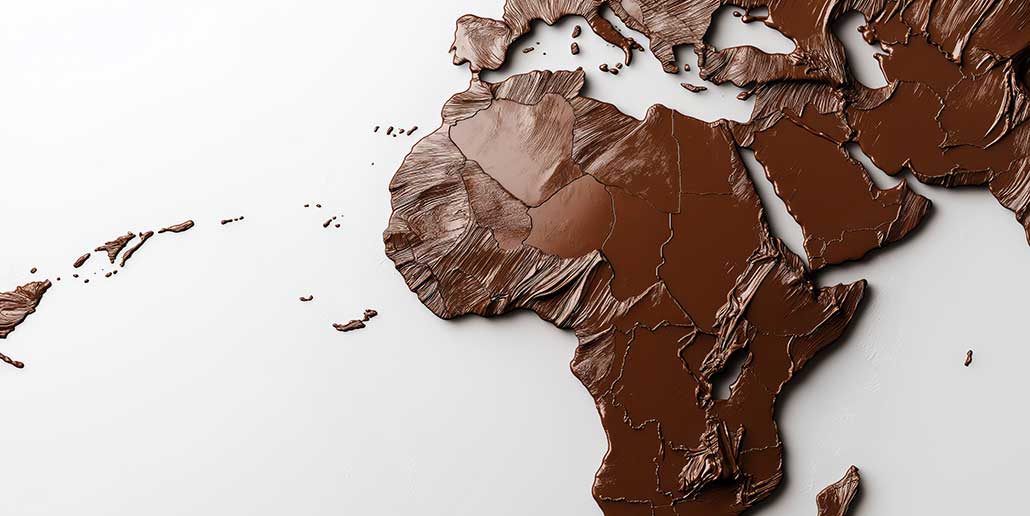
Africa’s Role in Chocolate
When you unwrap a chocolate bar, chances are high that the cacao inside it began its journey in Africa. The continent is responsible for about 70% of global cocoa production, yet for decades, it has been largely excluded from the wealth and recognition of the chocolate industry.
But the narrative is shifting. While Africa cocoa production continues to power the global chocolate economy, a growing number of African entrepreneurs, chocolatiers, and visionaries are reclaiming cacao’s value, crafting world-class chocolate within the very regions where the beans are grown.
Cocoa Farming Powerhouses: Ghana and Ivory Coast
Ivory Coast and Ghana are the twin titans of cocoa farming, together accounting for over 60% of the world’s cocoa bean supply. Cocoa farming is deeply woven into their economies, providing a livelihood for millions of smallholder farmers.
In Ghana, cocoa is often referred to as “black gold,” and its cultivation has been a source of national pride and economic dependency since the 19th century. Likewise, Ivory Coast has built a powerful agricultural economy centred around cacao exports.
Despite their dominance in Africa cocoa production, both countries face challenges: fluctuating global prices, lack of infrastructure, and limited access to the higher-value chocolate-making process. For decades, most African cocoa has been exported as raw beans, with value-added processes — like roasting, grinding, and conching — happening overseas.
The Hidden Costs: Fair Trade and Farmer Livelihoods
Behind the sweet taste of chocolate lies a bitter reality for many African cocoa farmers. Most small-scale farmers earn less than $1 per day, often unable to support their families or invest in better agricultural practices.
The issue of child labour and unsustainable wages has drawn international criticism, prompting the rise of Fair Trade, Rainforest Alliance, and other ethical certification systems. These programs aim to ensure farmers receive a fair price and work in safe, sustainable conditions.
Still, critics argue that certification systems only scratch the surface. True transformation will come when African producers control more of the chocolate value chain — from bean to bar. That’s where a new wave of local artisan chocolate makers is beginning to shine.
Madagascar’s Unique Fine-Flavour Cacao
While West Africa dominates in volume, Madagascar stands out for its fine-flavour cacao — a rare and highly prized varietal known for its fruity, floral, and citrusy notes. Grown mostly in the Sambirano Valley, Madagascar cacao is in high demand among premium chocolate makers worldwide.
Unlike the bulk cacao produced in Ghana and Ivory Coast, Madagascar cacao is often heirloom or Trinitario variety, processed with great care and traceability. As a result, it fetches higher prices and has opened doors for more direct trade relationships between Malagasy farmers and international craft chocolatiers.
More importantly, Madagascar is also beginning to retain some of the chocolate-making process on the island, with local companies producing finished chocolate bars that highlight the terroir and talent of the region.
Emerging African Artisan Chocolate Brands
Across the continent, a new generation of African-owned chocolate brands is emerging, determined to rewrite the narrative of Africa cocoa production. These companies are not only producing high-quality chocolate locally, but also investing in sustainable farming, education, and economic empowerment.
Some notable brands include:
- 57 Chocolate (Ghana): A woman-led bean-to-bar company that produces beautiful handcrafted bars made entirely in Ghana. Their mission is to inspire Africans to create more finished goods locally.
- Midunu Chocolates (Ghana): Founded by award-winning chef Selassie Atadika, this brand creates truffles infused with local African flavors like baobab, moringa, and Nigerian hibiscus.
- FairAfric (Ghana): A unique brand committed to producing 100% of its chocolate in Africa — from bean to bar — creating jobs and keeping profits within the continent.
- Madecasse (Madagascar): Now rebranded as Beyond Good, this company sources heirloom cacao directly from farmers and makes chocolate entirely in Madagascar.
These brands represent more than chocolate; they symbolize a movement — one where Africa is no longer just the farm, but the factory, the flavour innovator, and the final product creator.
Looking Forward: A More Equitable Chocolate Future
The global chocolate industry is slowly waking up to the need for equity, transparency, and sustainability. As consumers demand to know where their chocolate comes from — and how it’s made — African countries and entrepreneurs are stepping up with bold answers.
With growing access to technology, training, and international markets, Africa is poised to become not just the heart of cocoa production, but the future of global chocolate innovation.
NEXT UP: We’ll head to Oceania — from Australia’s growing craft chocolate scene to Pacific islands reclaiming their cacao heritage.

